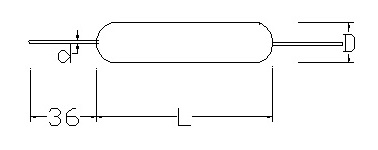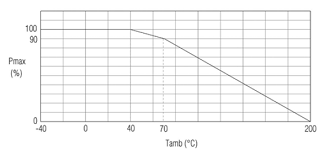
Introduction:
'SURE' provides fusible resistor which fuse or blow if they are subjected to an abnormal spike of voltage / current. SSF Series is a low cost resistor fusible resistor which provides circuit protection for overload or component failure. The resistor will open quickly under continuous load and prevent circuit board from damage and hazards.
Features:
· High Power to size ratio.
· High pulse load handling capabilities
· High temperature silicone coating with flame proof property.
· Non-inductive / Low inductive available on request
· Robust - Welded Construction
· Reliability against severity of environmental abuses.
· Instant Solder ability
· Resistant to Solvent
· Resistant to Alcohol
· ERTL type tested as per IS 8909
General Specifications:
|
DESCRIPTION |
SSF 01 |
SSF 02 |
SSF 2.5 |
SSF 04 |
SSF 06 |
SSF 09 |
SSF 12 |
SSF 15 |
SSF 20 |
|
Resistance (1) range , Series And tolerance (2)
± 10 %
± 5 % |
E24 Series |
||||||||
|
0.01 W - 0.05 W |
|||||||||
|
0.06 W - 100 KW |
|||||||||
|
Rated dissipation at T amb = 70 °C |
1 W |
2 W |
2.5 W |
4 W |
6 W |
9 W |
12 W |
15 W |
20 W |
|
Temperature coefficient. (3) |
R < 10 W: 0 to +600ppm/°C R ≥ 10 W: - 80 to +140ppm/°C |
||||||||
|
Operating temperature |
- 40 °C to + 200 °C |
||||||||
|
Basic specification |
IEC60 115-1 |
||||||||
|
Limiting voltage |
√ (Pn × R) |
||||||||
|
Stability D R/Rmax after:
Load
Climate tests
Resistance to soldering heat
Short time overload |
± 5.0% + 0.1 W
± 1.0% + 0.05 W
± 0.5% + 0.05 W
±2.0% + 0.1 W |
||||||||
(1) Special resistive values available on request
(2) Tolerances, 0.5, 1, 3 and 10% available on request
(3) Temperature coefficient, 30, 50 and 90ppm/°C, available on request
Mechanical Data:

Table 1. Mechanical data
|
PRODUCT |
L |
D |
d |
|
SSF01 |
12.0 ± 1.5 |
4.5 ± 0.5 |
0.80 ± 0.03 |
|
SSF02 |
14.0 ± 1.5 |
5.5 ± 0.5 |
0.80 ± 0.03 |
|
SSF2.5 |
16.0 ± 1.5 |
5.5 ± 0.5 |
0.80 ± 0.03 |
|
SSF04 |
18.0 ± 1.5 |
6.5 ± 0.5 |
0.80 ± 0.03 |
|
SSF06 |
26.0 ± 1.5 |
7.5 ± 0.5 |
0.80 ± 0.03 |
|
SSF09 |
34.0 ± 1.5 |
8.5 ± 0.5 |
0.80 ± 0.03 |
|
SSF12 |
54.0 ± 1.5 |
7.5 ± 0.5 |
0.80 ± 0.03 |
|
SSF15 |
54.0 ± 1.5 |
8.5 ± 0.5 |
0.80 ± 0.03 |
|
SSF20 |
67.0 ± 1.5 |
9.5 ± 0.5 |
0.80 ± 0.03 |
OPTIONS AVAILABLE:
· Long lead (50 mm) on either side
· Extra Long Lead (65 mm) on either side.
· Thick lead (1.0 mm) on both sides.
Construction:
SSF: The resistor element is a resistive wire, which is wound, in a single layer, on a ceramic rod. Metal caps are pressed over the ends of the rod. The ends of the resistive wire and the leads are connected to the caps by welding. Tinned copper clad iron leads with poor heat conductivity are employed permitting the use of relatively short leads to obtain stable mounting without overheating. The resistor is coated with green silicon cement which is non-flammable, will not drip even at high overloads and is resistant to most commonly used cleaning solvents
Electrical Characteristics
DERATING: The power that the resistor can dissipate depends on the operating temperature.

Maximum dissipation (Pmax) in percentage of rated as a function of ambient temperature (Tamb)
Test and Requirements
Essentially all tests are carried out in accordance to the schedule of IEC publications 60115–1, category 40/200/56 (rated temperature range -40 to +200 °C; damp heat, long term, 56 days and along the lines of IEC publications 60068-2); “Recommended basic climatic and mechanical robustness testing procedure for electronic components” and under standard atmosphere conditions according to IEC 60068-1 subclause 5.3, unless otherwise specified.
In some instances deviations from IEC applications were necessary for our method specified.
Table 8. Test and requirements
|
TEST |
PROCEDURE |
REQUIREMENTS |
|
Temperature coefficient |
Between - 40 °C and + 200 °C: R < 10 Ω R ≥ 10 Ω |
0 to 600 ppm/°C - 80 to +140 ppm / °C |
|
Rated Load |
Rated wattage for 30 minutes | ±(1% + 0.05W) |
|
Short time overload |
2.5 times the rated wattage for 5 sec |
ΔR/Rmax ±2% +0.1 |
| Insulation Resistance | 500 V DC | ³1000MW |
|
Robustness of terminations:
Tensile all samples
Bending half number of samples
Torsion other half number of samples |
Load 10 N; 10 s
Load 5 N; 4 x 90°
2 x 180° in opposite directions |
No visual damage ΔR/Rmax ±0.5% +0.05 |
|
Solderability (after ageing) |
16 h at 155 °C; leads immersed in flux 600, leads immersed 2 mm for 2 ± 0.5 s in a solder bath at 235 ±5 °C |
Good tinning; (≥95% covered) No Visible Damage |
|
Resistance to soldering heat |
Thermal shock: 3 s; 10 °C; 2.5 mm from body |
ΔR/Rmax ±0.5% + 0.05 |
|
Rapid change of temperature |
30 minutes at - 40°C and 30 minutes at + 200°C; 5 cycle |
No visible damage ΔR/Rmax ±1% + 0.05 |
|
Vibration |
Frequency 10 to 500 Hz (1 to 7W) and 10 to 55 Hz (10 to 20W),displacement 0.75 mm or acceleration 10 g, three directions; total 6 h (3x2 h) |
No visible damage ΔR/Rmax ±0.5% + 0.05 |
| Incombustibility | 6 times the Rated wattage for 5 minutes | Not flammable |
NOTE : Fusible resistors are not standard resistor types and each type of fusible resistor must be designed to suit a particular application.
Data required to design a fusible resistor are:
-
The type you require -
Ceramic Encased or Axial Lead Type -
Resistance in ohms.
-
Power rating in terms of watts.
-
Tolerance.
-
Fusing current - The current at which the resistor must fuse or blow.
-
Fusing time - The duration within which the resistor must fuse or blow, on being subjected to the fusing current.
At SURE if no special data is provided, a fusible resistor can be made as per the following chart :
FUSING CHARACTERISTICS :
|
POWER |
FUSING TIME |
|
MAX |
|
|
16 X Wattage |
1 min |
|
20 X Wattage |
40 sec |
|
24 X Wattage |
30 sec |
|
28 X Wattage |
20 sec |
|
32 X Wattage |
15 sec |
TYPICAL APPLICATIONS :
As mentioned previously a fusible resistor is a dual purpose
component -
(a) In normal conditions it functions as a resistor.
(b) In high overload conditions it acts as a fuse/safety device.
In some countries all types of ceramic encased
type resistors are wrongly called as fusible resistors. It must be clearly
understood that fusible resistors are special purpose, specially designed
resistors and are produced mainly in two configurations -
(a) Ceramic encased type (SCF) and
(b) Flame retardant silicone coated axial lead type.